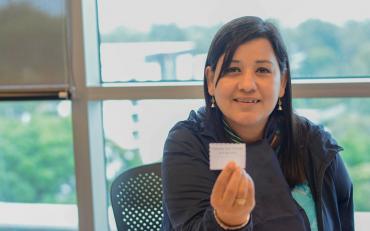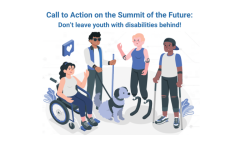This is one story as part of the Voices of People with Disabilities during COVID19 Outbreak series
“We are persons with disabilities but we are also indigenous, we have our own challenges, we have been historically marginalized in our own country, and we have never been part of the discussion. I am also a woman and we are not part of the feminist discourse either”, says Pratima.
Pratima Gurung, is an activist for the rights of Indigenous peoples and women with disabilities in Nepal and Asia. She is General Secretary for Indigenous Persons with Disabilities Global Network and Nepal Indigenous Disabled Association (NIDA), Chair of the National Indigenous Disabled Women Association Nepal (NIDWAN) and a faculty member at Padma Kanya College in Kathmandu.
Pratima is an indigenous women with a disability who lost one of her hands when she was very young. She explains that official government information regarding COVID-19 outbreak is very limited and mostly in Nepalese or English. “I am the most privileged person in my community as I am able to understand and speak in English and Nepalese”, she says.
Indigenous Peoples in Nepal make up for 35.81 per cent of the country's total population (approximately 8.5 million out of the 26 million Nepalese)[1]. Despite constituting such a significant portion of the population, indigenous peoples have been marginalized in terms of language, culture and political as well economic opportunities throughout the history.
As per the 2011 census, Nepal has 126 castes and ethnic groups speaking as many as 123 languages. And 90 percent of these languages are spoken by Indigenous Peoples.
Indigenous Peoples in Nepal have distinct cultures, languages and belief systems. They live across the country but most of indigenous people live in remote and rural areas and make a living out of subsistence farming.
Barriers in accessing communication
Pratima explains that the main issue regarding COVID-19 is the language barrier as most indigenous communities do not speak Nepalese and many are illiterate. Official information and communications on COVID-19 are disseminated in the national language and remains mostly inaccessible. Many government bodies and different development partners which are disseminating information do not take into consideration the perspective of persons with disabilities, and indigenous persons. Many technical words were used such as self-isolation that are difficult to explain. This can be an issue to reach marginalized groups. Complex language in English such as that present in UN documents causes barriers in the communication.
The government included sign language and other forms of accessible information after the third week since the state of emergency was declared. However, information in local languages is still not taken into consideration. “Information in local language is as important as sign language for deaf people, it’s the right to access information”, she says. Pratima explains that most persons with disabilities in Nepal are from indigenous communities, and most of them do not know about the Convention on the Rights of Persons with Disabilities (CRPD) nor their rights (adopted in 2011). They are often very hard to reach as they do not have cellphones or others means of communication. “I have knowledge and that makes me privileged”, she says. The lack of information on equal basis has severe consequences, for instance, deaf persons remain marginalized due to an absence of sign language interpretation.
Moreover, translating common words being used during the outbreak to local languages remains a challenge. “Imagine those who are illiterate, they don’t know what social distance means, or sanitizer, let alone COVID-19 and the impact of the virus”, she says. Lack of understanding of concepts means there are entire populations that remain unprotected and exposed to the virus. An example is that not all indigenous communities knew of the lockdown or even coronavirus in the first week. “This is a direct violation of the right to accessible information in one’s mother tongue”, she says.
In addition, the government did not inform the population with sufficient time that persons in the city and urban areas must return to their home in rural areas. This meant that many people with disabilities were unable to plan accordingly how and when they would go back home safely. Information was not accessible and widely spread in advance, meaning many are currently trapped in the city. Also, many wheelchair users were unable to go home in crowded vehicles both due to the lack of space and inaccessibility of transport.
Intersectionality
Pratima stresses the importance of having an intersectional approach during COVID-19, and understanding that persons in Nepal are exposed to multiple sources of discrimination due to their ethnicity, gender, disability, etc. For instance, public statements don’t include the perspective of indigenous women with disabilities. “Our voices are still unheard”, she says. “Information has to represent all persons with disabilities and clearly mentioned, otherwise we are lumped into one basket and that is how we get excluded, not only during COVID-19 but disaster situation and normal life”
Moreover, when presenting government measures and plans, there is no mention of accessibility or gender specific needs, meaning many groups of the population remain marginalized, due to a lack of intersectional approach. “Government and development agencies are applying the one size fits all approach”, she says. A way of avoiding this is meaningful participation and consultation of different groups to understand that for instance, the needs of women with disabilities are different to men with disabilities. “This is vital to avoid social exclusion as persons with disabilities are not a homogenous group”, says Pratima.
Issues related to gender remains invisible. For instance, the rates of violence and discrimination has increased, and suicidal rates are growing. More specifically, gender-based violence, and private-sphere violence has intensified. “This is situation is different to the time where earthquakes have occurred because persons were accommodated in open and shared spaces, whereas now, women remain indoors and can’t report this information”, she says. Social protection is lacking as very few cases are being reported to the police. “Civil society organisations and governments are focused on other priorities in the agenda but specific needs are not taken into account”, she says
National Federation of the Disabled Nepal (NFDN), which includes 350 DPOs in Nepal, made a survey on COVID-19. Questions on disability, age, social status, employment, gender were included but there was no mention to caste and ethnicity. “Indigenous persons with disabilities are left behind and this is mainly because indigenous organisations of persons with disabilities were not consulted. If DPOs continue to exclude certain groups, what can we expect from the government?”, she says.
Food and water shortages
Scarcity to food and water is an issue in Nepal, as in many other countries in the world. She mentions the case a woman with a visual impairment who would have to walk for half an hour to obtain clear water. This means she has to rely on others and faces severe challenges to cook and wash her hands. Moreover, information is not accessible for blind persons therefore, she misses much information on COVID-19 and sanitation guidelines.
In rural parts of the country, food shortages are not a such an issue as for persons with disabilities residing in the city. Due to movement restrictions and lack of available food, many are experiencing starvation.
Moreover, the government has made a provision to obtain relief packages containing food (for example rice and lentils), but in order to obtain it, one must have proof of citizenship and/or disability. This poses an issue for indigenous persons with disabilities, who often do not have official documentation for either. Pratima explains that the reason for this can be attributed to many socioeconomic factors, such as family members not accepting persons with disabilities, many being part of a low cast, or due to poverty and illiteracy. She is aware of local government representatives denying relief packages for people with disabilities, and their needs are rarely prioritized. “Many are being left behind”, she says.
Access to health
As the government did not provide sufficient and clear information on COVID-19 and its restrictions, many persons with disabilities have been unable to stock up on their medicine, medical kits and clinical apparatus. Another issue is for persons with disabilities in need of medical attention that are often dismissed at hospitals if its not COVID-19 related. She is aware of the case of a man with hemophilia who had blood in urine since one week and was denied medical attention. He currently does not receive any medical support nor medication.
There is also stigma around getting tested for COVID-19 and not all people from the villages and rural areas are open to it, meaning persons with disabilities are not receiving sufficient medical attention. “The daily routine for COVID-19 such as check-up, tests, isolation does not take into account the perspective of persons with disabilities” says Pratima. Moreover, there is a lack of disaggregated data. There is no data collection of persons in quarantine, how many are suspected, how many have come to hospital, let alone data including persons with disabilities.

